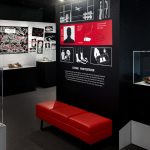In what was once an old Piggly Wiggly Grocery store and more recently a transmissions shop, Half-Moon Outfitters has completed what might be the “greenest” renovation in the country. The new Half-Moon corporate office and warehouse has just been awarded the U.S. Green Building Councils LEED (Leadership in Energy and Environmental Design) Platinum. The LEED rating system recognizes projects for having sustainable site conditions, selecting environmentally preferred materials, providing a healthy indoor environment, and using water and energy efficiently. Half-Moon becomes only the nations 25th new construction or major renovation to receive a Platinum rating and is the very first to do so using the newer, more stringent LEED NC version 2.2. It is also the first LEED Platinum project in the state of South Carolina.
The 9,600 square foot building is located in an up and coming part of North Charleston, S.C. known as Park Circle. Half-Moon joins a small number of restaurants and small businesses that are breathing new life back into this previously blighted area that was hard hit by the closing of the Navy Base over a decade ago. What was once an unadorned concrete building with few windows and an oversized parking lot has been transformed into an attractive and welcome location with photovoltaic panels on the roof, rainwater collection tanks in back, extensive native vegetation, and a brightly lit interior almost entirely of locally harvested wood, salvaged materials, and rapidly renewable agrifiber boards.
According to Beezer Molten, the owner of Half-Moon Outfitters, “The building was perfectly situated to rebuild in the most Green way possible”. The building has east-west orientation, which facilitates both passive and active solar energy collection. The flat white membrane roof keeps the roof cool while directing all rainwater to two-1550 gallon storage tanks. Water efficiency fixtures combined with the use of rainwater to flush toilets results in the building using 78% less domestic potable water than a conventional building. After the first year, the native landscaping requires no irrigation, further reducing potable water demands. Extra insulation was added throughout the building to dramatically reduce HVAC loads and allows the 4900-watt photovoltaic solar system to offset a more significant portion of total energy needs. With the help of his engineering team (DWG Inc), Molten elected to go with a newly introduced 19 seer Lennox heat pump system that rivals the efficiency of a geothermal HVAC system that the team had considered. Additional energy efficiency measures include varying the buildings ventilation rates according to carbon dioxide levels and the electric light levels via dimming ballast and photo sensors, taking advantage of the now abundant sunlight. The entire building utilizes just three types of energy efficient fluorescent lamp making rare bulb changes easy for all.
The small development group Reavis Comer Development handled the construction side of the build-out, and Molten/Lamar architects of Columbia S.C. designed the space. The architect is the owners father, whom according to Beezer Molten “
educated me in the ways of Green construction long before such a phrase was popular.” Employees at Half-Moon have gotten behind the effort and helped in much of the documentation and sourcing of the various products needed to complete the project. Furthermore, the building is succeeding in transforming the way Half-Moon Outfitters does business, as they have started a scorecard for all of their locations that measures and compares the power needs of each of their locations per square foot per month. The new project in North Charleston currently varies between 3 cents and 5 cents per square foot per month while their most inefficient store operates between 20 cents and 30 cents per square foot, a statistic that Molten vows to change.
“A shift has occurred with the mentality of our employees as everyone is becoming committed to the idea of recycling and reducing our consumption of carbon based fuels. One employee has even purchased an older bio-diesel Mercedes from California, which earns him the best spot in our parking lot.” According to Katherine Smith, Half-Moons graphic designer, the single greatest element of the new office and distribution center are the Dakota Burl desks. Dakota Burl is a compressed sheet board, which looks like OSB or particleboard but is actually comprised of discarded sunflower husks, a rapidly renewable resource. She says, ” the desk remind us that we are living and working in a special place, and that we need to think about our consumer choices everyday, not to mention the texture of the sunflower seeds is crazy- cool”.
Nathan Gauthier, a former Half-Moon employee, and now green building consultant and Assistant Director at the Harvard Green Campus Initiative in Cambridge, Mass., oversaw all aspects of LEED compliance, documentation and certification during the renovation for the Half-Moon facility. He is using the success of this building to influence the design of projects at Harvard and elsewhere and is featuring the Half-Moon case study in a green building course at the Harvard Extension School.
“Working with Beezer and his team was a great experience. The team was open to considering alternative solutions, regardless of previous exposure to the technologies or techniques, and everybody had suggestions of innovative strategies to improve the buildings performance. The design came together as a practical and comprehensive solution to the buildings specific conditions. Im sure others will benefit from the tremendous success of Half-Moons project.”















